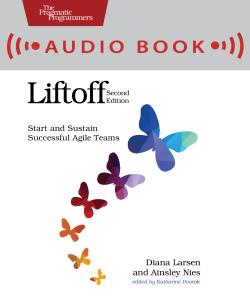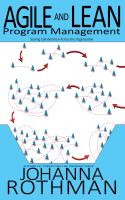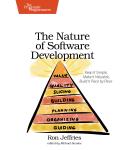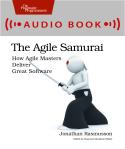By Developers, For Developers
About This Title
Pages:
Published: September 2017
ISBN:
In Print
Liftoff, Second Edition (audio book)
Start and Sustain Successful Agile Teams
by Diana Larsen and Ainsley Nies
Ready, set, liftoff! Align your team to one purpose: successful delivery. Learn new insights and techniques for starting projects and teams the right way, with expanded concepts for planning, organizing, and conducting liftoff meetings. Real-life stories illustrate how others have effectively started (or restarted) their teams and projects. Master coaches Diana Larsen and Ainsley Nies have successfully “lifted off” numerous agile projects worldwide. Are you ready for success? Also available in paperback and ebook formats.
Listen to an excerpt from Chapter 3.Buy the audiobook here for $24.99 Available in mp3, m4b, and ogg formats except as noted.
Every team needs a great start. If you’re a business or product leader, team coach or agile practice lead, project or program manager, you’ll gain strategic and tactical benefits from liftoffs.
Discover new step-by-step instructions and techniques for boosting team performance in this second edition of Liftoff. Concrete examples from our practices show you how to get everyone on the same page from the start as you form the team. You’ll find pointers for refocusing an effort that’s gone off in the weeds, and practices for working with teams as complex systems. See how to scale liftoffs for multiple teams across the enterprise, address the three key elements for collaborative team chartering, establish the optimal conditions for learning and improvement, and apply the GEFN (Good Enough for Now) rule for efficient liftoffs. Throughout the book are stories from real-life teams lifting off, as seasoned coaches describe their experiences with liftoffs and agile team chartering.
Focused conversations help the team align, form, and build enough trust for collaborating. You’ll build a common understanding of the teams' context within business goals. Every liftoff is unique, but success is common!
A Handful of Liftoff Design Principles
by Diana Larsen and Ainsley Nies
Each development effort is unique, so every liftoff is unique. As a planning group member, design your liftoff for the combination of attributes at hand. Consider the nature of the product, the nature of the work, and the people. Take into account the knowns and unknowns. Think about the work environment and the circumstances driving delivery.
Here’s where it gets tricky and where you’ll need to get agile when you’re working on a liftoff design. There is no cookie-cutter approach, standard recipe, or a best practice template. Your unique team characteristics will drive many of the design decisions.
When you design a liftoff, your planning outcomes guide format choices. Planning influences how you develop the flow. You design how to start and how to end, and make other format choices that fit in-between. Select design elements to establish a rich atmosphere for effective communication. Base your selections on your planning group’s intention for the liftoff. Use the following handful of design principles to guide your handiwork.
Thumb
The best liftoffs create a sense of ownership of the outcomes. Create a
liftoff design where all participants engage as owners in the process.
Their sense of ownership helps sustain commitment to outcomes. It
influences the work until final delivery.
Index Finger
Only include activities in the liftoff that have a real work purpose.
Liftoff participants engage best when they focus on relevant activities.
Choose agenda items related to achieving the liftoff intentions and
outcomes.
Third Finger
Every liftoff needs a sponsor or executive introduction. Every team
needs to hear directly and unambiguously from the top. Team members need
to know they have organizational support and commitment for their
effort. If your sponsor can’t make time to show up, maybe the product
launch isn’t a top priority, after all. Their presence or absence sends
a message.
Ring Finger
Every work group and team needs agile chartering. It accelerates common
understandings. Sooner or later, team members and the business wrestle
with defining the work in the same way. Including chartering in the
liftoff gains understanding early and precludes time wasted later on.
Pinkie
Take the time to include participants in design decisions. You’ll get a
better liftoff outcome if you ask for and include their opinions. Seek
ideas about training topics, planning needs, and other uses of their
time.
What You Need
Resources
Releases:
Contents & Extracts
- Acknowledgments
- Introduction: Defying Gravity
- What Is a Liftoff?
- Why We Wrote this Book
- What’s Inside?
- Who Will Benefit From Reading this Book?
- Plan for a Successful Liftoff
- Are You Ready to Plan a Liftoff?
- Who Plans the Liftoff?
- Planning the Liftoff
- It’s Never Too Late
- What’s Next?
- In Practice: Team Restart
- Navigate Learning Environments
- Setting Conditions for Optimal Team Learning
- Focus on Learning
- What’s Next?
- In Practice: Applying the Rules
- Design a Great Liftoff for Your Team
- Initial Design Considerations
- Designing the Start
- The Heart of Your Liftoff
- Ending Your Liftoff
- What’s Next?
- In Practice: A Kickoff Workshop Gem
- Smooth the Path to Performance with Agile Chartering
- What Is Agile Chartering?
- Leading the Two Parts of Chartering
- Amending the Living Charter
- What’s Next
- In Practice: The System Tracking Project
- Charter a Clear Team Purpose
- Understanding Purpose
- How to Facilitate Agile Chartering for Purpose
- What’s Next?
- In Practice: How a Team Found the Power of Purpose
- Create Coherence by Chartering Alignment
- Understanding Alignment
- How to Facilitate Agile Chartering for Alignment
- What’s Next?
- In Practice: Team Building in Transition
- Charter Context to Influence Work
- Understanding Context
- How to Facilitate Agile Chartering for Context
- What’s Next?
- In Practice: A Tale of Two Projects
- Soar from Liftoff to Flight
- Preparing For a Liftoff Retrospective
- Conducting a Liftoff Retrospective
- Keeping the Team Charter Alive
- Have a Great Flight!
- In Practice: The Yardbirds
- Sample Charters
- Mobile App Team
- Team Kurtulmak
- Team Lightning
- Sample Chartering Agendas
- Prework Session Agenda
- Agile Team Chartering Agenda
- Contributor Biographies
- Liftoff Co-Authors
- In Practice Authors
- Illustrator
Author
A founder of FutureWorks Consulting in Portland, Oregon, Diana Larsen partners with leaders around the world to design work systems, improve team performance, and transition to Agile methods. Diana co-authored Agile Retrospectives: Making Good Teams Great and Quickstart Guide to Five Rules for Accelerated Learning. She also co-created the influential Agile Fluency model.
As principal of Acorn Consulting, Ainsley Nies’ work focuses on developing sustainable work environments for learning and improvement. With more than 20 years’ experience as a program/project manager in a Fortune 100 company, Ainsley enables clients to capitalize on the insights they have and discover the knowledge they need. She teaches a variety of agile management courses in university programs.
Buy the audiobook here for $24.99 Available in mp3, m4b, and ogg formats except as noted.
Related Titles:
About This Title
Pages:
Published: September 2017
ISBN:
Edition: 1
In Print









